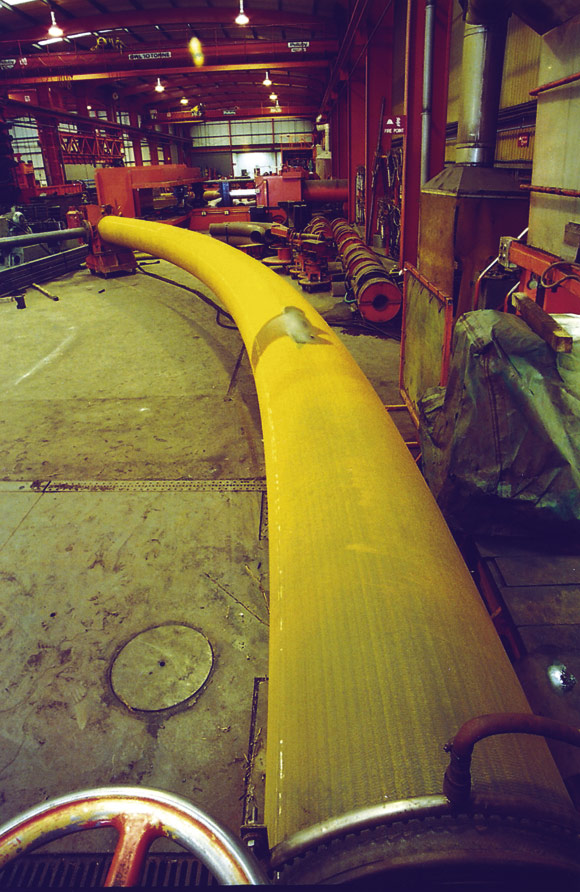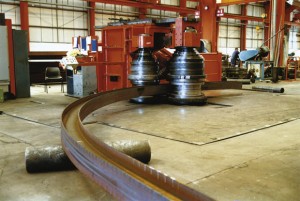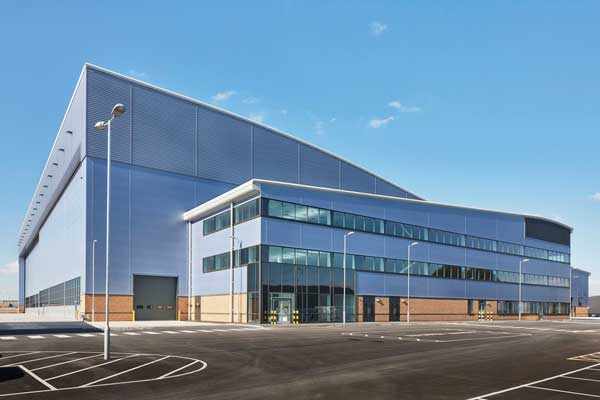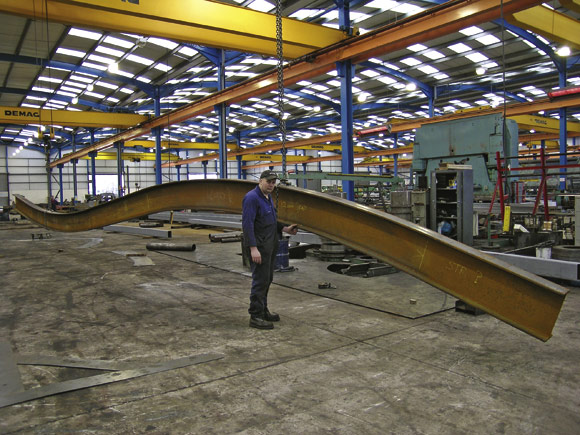Profile
On an upward curve
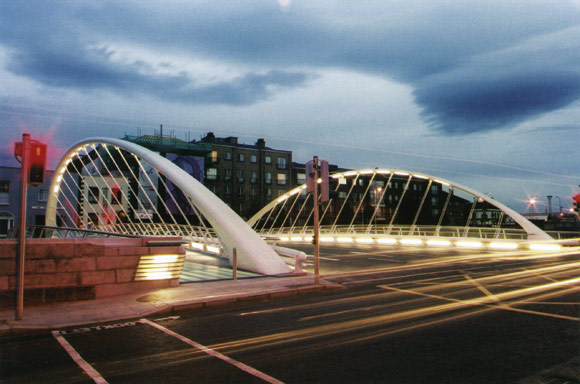
The James Joyce bridge in Dublin is one of the prestigious structures for which the company has bent steel
Fifty years’ experience and an approach based on engineering principles has given Angle Ring unsurpassed versatility in the growing market for curved steel. David Fowler reports.
Angle Ring is one of the biggest curved steel specialists in Europe and is proud to boast that in just over half a century of existence it has been consistently responsible for its fair share of market innovations.
Angle Ring Marketing Manager Paul Middleton puts this down to the fact that the company is engineering-led. The company undertakes both cold bending and induction bending, but in both areas, he says: “We design and build many of our own machines. We can make them do exactly what we want them to do.”
That gives the company an extremely wide range of jobs it can tackle. “We can bend anything up to the largest sections Corus makes,” says Managing Director David Springthorpe. “People are often surprised at our capabilities.”
Started in 1951 and named after its main product, angle section bent into rings as stiffeners for West Midlands manufacturers, Angle Ring now finds most of its £8M turnover comes from the construction market. Middleton points out that in the Victorian age, when cast and wrought iron were the key construction materials, buildings with curves were common, because cast iron could easily be cast into curved shapes. From around the turn of the century, as steel became more widely available, buildings became essentially linear, rectangular boxes. Since the 1970s, the aesthetic appeal of curves has led to a resurgence in demand for curved sections.
Angle Ring has supplied curved steelwork for prestigious projects from Wembley Stadium to Manchester’s B of the Bang sculpture, and the James Joyce bridge in Dublin. Other jobs are less well-known. “We do some fantastic projects that are never really publicised, such as some company HQs,” says Mr Springthorpe.
Angle Ring started designing its own machines because nothing available on the market would satisfy its customers’ demands. “You can’t buy a machine today to match ours,” says Mr Springthorpe. “You can get one to do boxes, tubes and flats but not universal beams, and vice-versa. Ours do everything.”
Angle Ring got into induction bending in an effort to keep the company moving forward. Again, it found the range of machines limited. They were generally designed for bending tubes for the petrochemical and offshore industries. “In those markets you usually want a 90° bend in the smallest space. If the radius is 1m, 1050mm or 950mm it doesn’t matter,” says Mr Springthorpe. “In the structural market they specify a definite radius.” Again the solution was to design a bespoke machine. “At the same time we removed a lot of limitations that normally applied, such as a maximum radius. We developed mechanisms for getting an accurate radius, and we have additional machines to adjust the bend afterwards if needed.”
The majority of the company’s work continues to be cold-bending, for which it has far more capacity. “Induction bending is fantastic but does involve a higher production cost than simple cold rolling. The machines are more complicated and need a lot of maintenance,” says Mr Middleton. He adds, however, that although induction bending machines need more attention, “because we designed and built them and have our own maintenance department, most problems can be fixed relatively quickly.”
There is no clear dividing line to define whether cold bending or induction bending is preferable for a given project. Generally induction bending is favoured for large sections, especially hollow ones, because the risk of the section distorting or collapsing is greater. “We try to find the most economic solution,” says Mr Springthorpe. “For example, with a 300mm square section it may be more economic to increase the wall thickness from 10mm to 12mm and bend it cold rather than keeping the thinner wall and having to hot bend it. There’s a large grey area where we offer advice.”
As a rule of thumb, hollow sections above about 600mm are more likely to need induction bending.
The decision also depends on whether slight distortion or rippling is acceptable, which in turn depends on how visible the section will be. Mr Springtorpe gives the example of a curved tube used as a guide for the cable of a cable-stayed bridge. Slight internal rippling will not be visible, so provided the cable will go through the tube freely the rippling will not be critical.
Induction bending, in which about 25mm of the section is heated electromagnetically as it passes through the machine, allowing it to be bent at the heated point, tends to be a slower process. Cold bending is a cyclic process in which the component is repeatedly bent by a small amount, but it still takes a relatively short time. Induction bending is a single pass process but slower because it requires more setting up, and also because it takes a certain amount of time for the section to heat up. So it may only progress at a rate of 25mm/minute if the section has a thick wall, although most sections are curved at faster speeds.
Engineers generally have little training in how to design curved steel members. Design is complicated by a number of factors. First, the steel has been strained, which will increase its yield point and means that some of its reserves of strain have been used. Residual stresses can also be significant. Material properties can be restored by heat treatment if necessary.
The fact that members are curved means loads become eccentric and torsion can be introduced, leading to warping on I-beams. Stability against buckling and the appropriate effective length to be used in calculations are affected. And there are difficulties in modelling all these effects in CAD programs designed for straight members.
For a number of years, Angle Ring with the Steel Construction Institute has run seminars dealing with these issues, and with the SCI and Barnshaws Steel Bending, produced the SCI specialist guide, The Design of Curved Steel.
Though most of its work is now in structures, Angle Ring continues to supply the mechanical engineering and process markets. A recent job was for Airbus, making highly accurate steel frames for moulds used in vacuum-forming carbon fibre airframe components. Another project involved bending an 800mm sheet of 180mm thick plate to form the motor casing for an electric generator.
Driving the structures market, says Mr Middleton, is the fact that architects and the public want buildings that look more interesting, and that generally involves curved sections. Demand for prestige structures such as stadiums is expected to continue. For different reasons, County Councils are becoming big customers. With the focus on inner city regeneration, more thought is going into building design. A percentage of funding on highway schemes to be spent on works of art has meant an upsurge in “island art” — sculptures to decorate traffic islands.
For the future Angle Ring is continuing to develop the range of three dimensional bending. Another new service is making bespoke polygonal box sections by bending them from plate and then welding them together. The finished section may subsequently be bent. This technique is likely to have applications where standard sections are not suitable because of restricted space or high loading, and a wall thickness greater than 20mm is needed. “We have a job coming up shortly where we’re making some 500 x 500 x 25mm and 500 x 300 x 25mm sections for a bridge,” says Mr Springthope.
“As far as developing the market goes, being engineering-led gives us an advantage,” he adds. The overall philosophy, he says, is this: “We’re trying to push the market towards new things. Unless we make people aware of what we can do they won’t design that way.”
Angle Ring’s Foundations
Angle Ring was founded in 1951 to supply local mechanical engineering firms in the West Midlands. 54 years later the firm is still expanding on the same site in Tipton near Wolverhampton.
As time progressed the company developed the capacity to bend larger and larger sections and the market changed to become primarily structural, though the company still works for the manufacturing and process industries.
The founder had two sons, one of whom still owns the company; the other left in 1969 to set up Angle Ring’s biggest competitor, Barnshaws Steel Bending, based a few miles away.
Between them these two command between two-thirds and three-quarters of the UK market for steel bending.
While Barnshaws has also diversified into areas such as profiling, Angle Ring has concentrated on developing its original speciality, bending, and is able to tackle an extremely wide range of projects. “By the early 1980s we could bend everything Corus made,” says Angle Ring’s David Springthorpe.
In 1992 it designed its first induction bending machine and has been active in both the cold and hot bending markets ever since.









